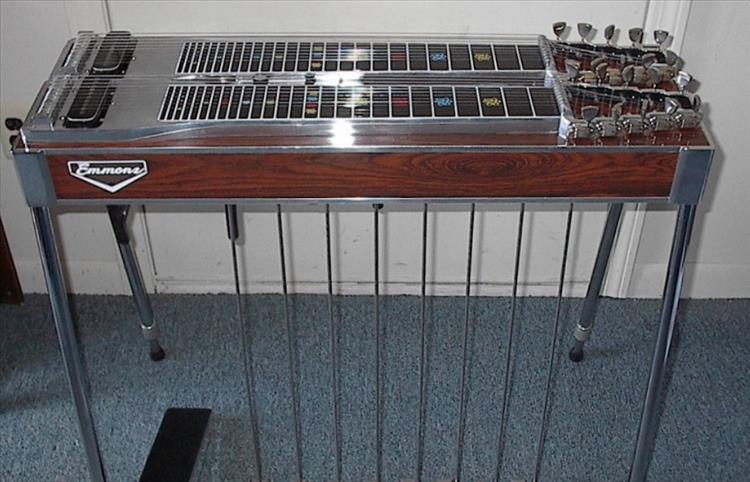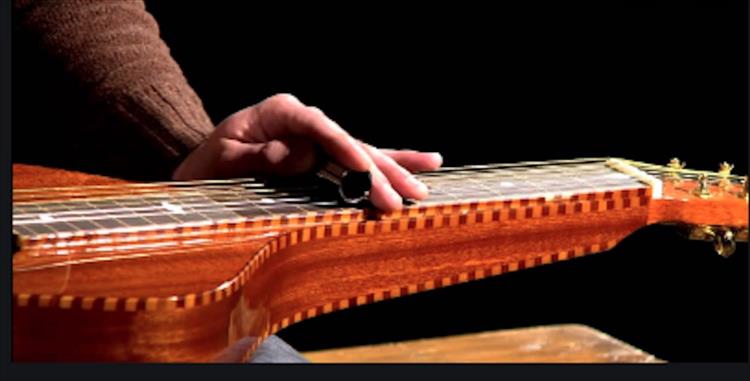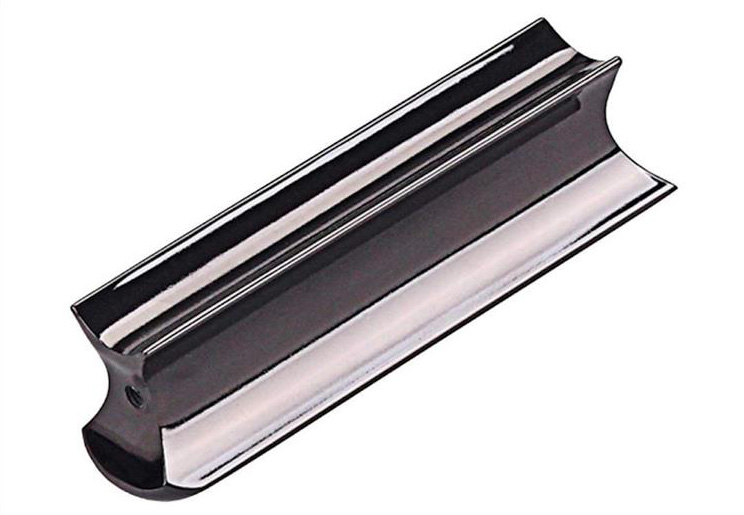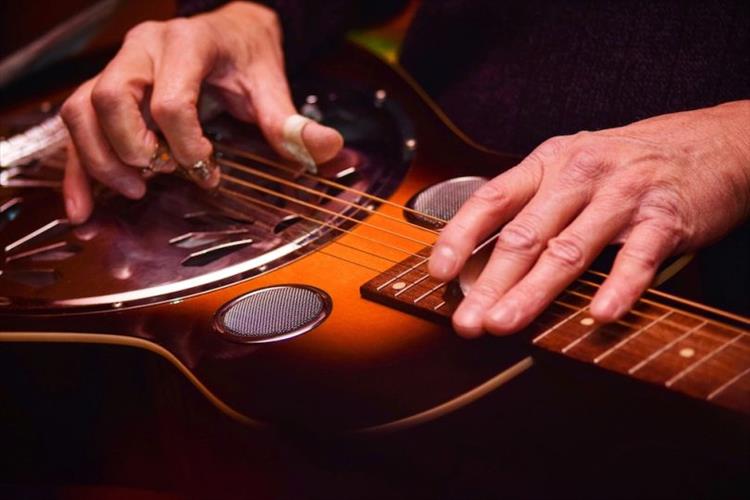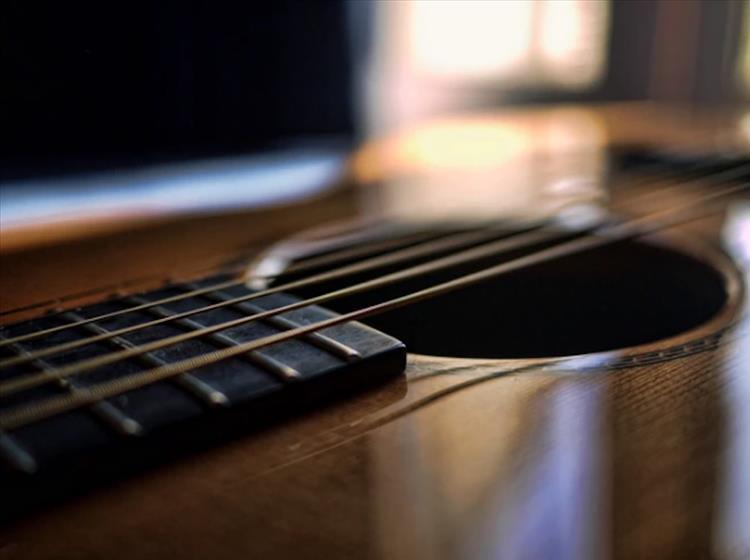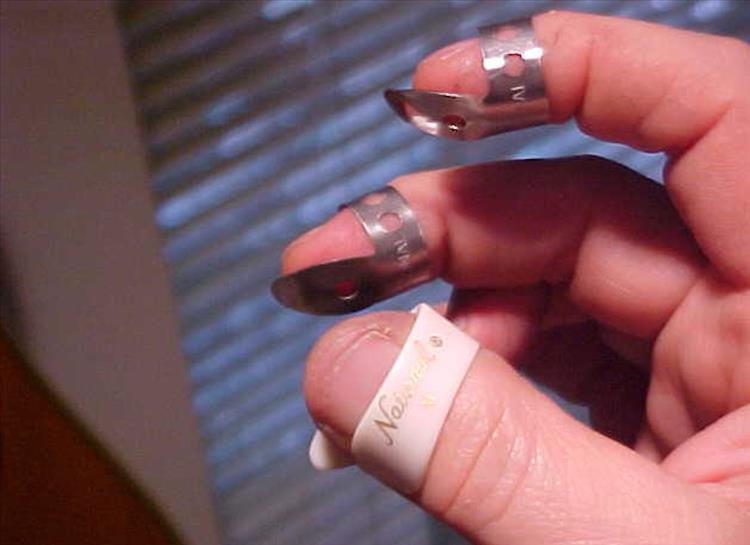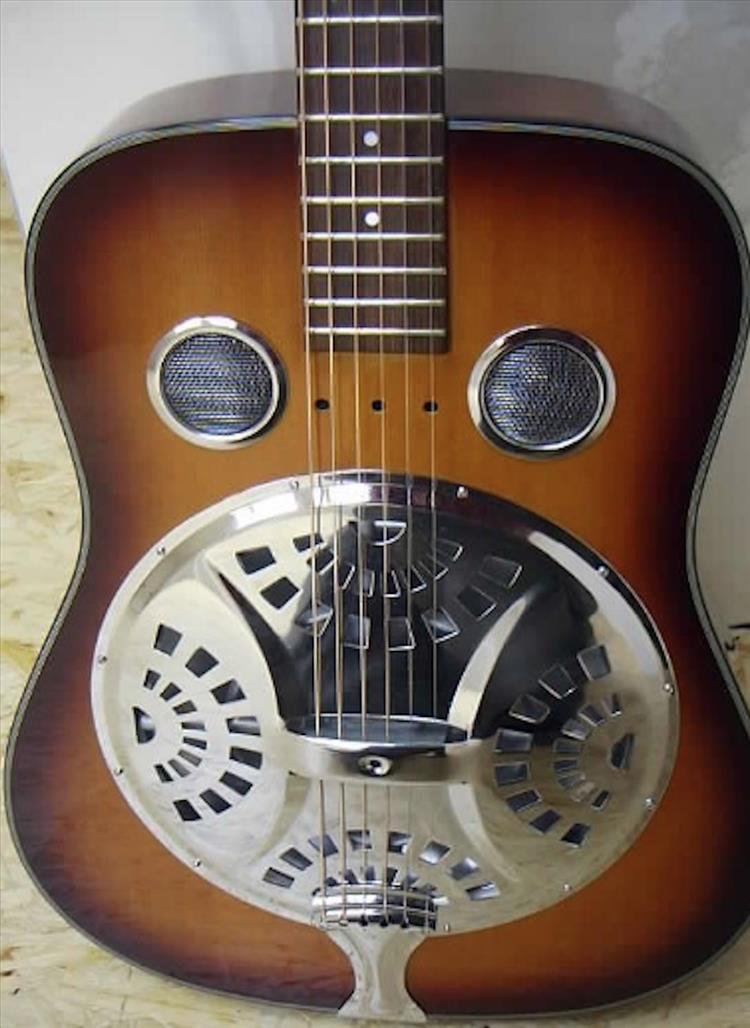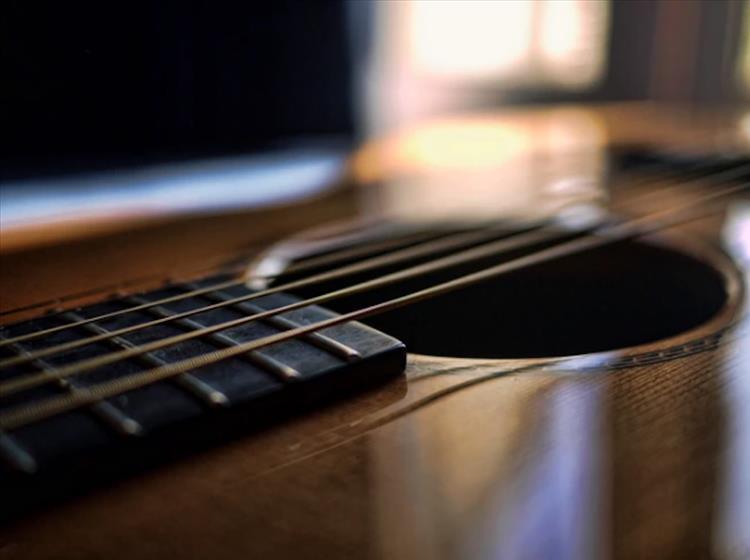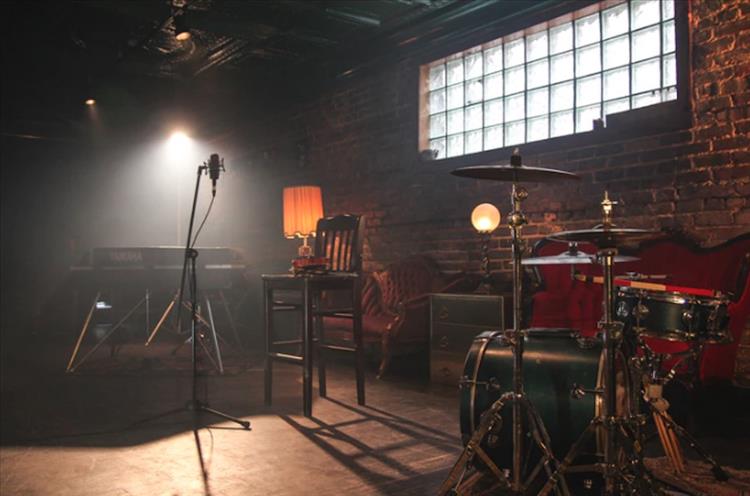Steel guitar is an interesting instrument – Let us start you off with your first steel guitar lessons!
Over 250,000 guitar-learners get our world-class guitar tips & tutorials sent straight to their inbox: Click here to join them
In this free lesson you will learn…
- 10 tips for playing steel guitar
- The difference between a lap steel guitar and a Dobro
- How to use a tone bar
- How to play using open tunings
Steel Guitar Lessons Are Fun!
Has someone dropped a steel guitar into your lap?
- Have you heard the amazing sounds of the steel guitar and you can’t wait to make those sounds yourself?
- Maybe you’re just curious about what the difference is between a steel guitar and any other guitar?
Regardless, we’ve got the answers for you! Today you’re going to learn everything you always wanted to know about these unique instruments, and you’ll have your first steel guitar lessons right here.
Although steel guitars come in a few different forms, we’re going to focus mainly on the lap steel guitar and its wearable cousin, the dobro.
This is a pedal steel guitar. We can virtually guarantee that it hasn’t been dropped in your lap, because if it had, your lap would be broken.
The pedal steel guitar is a dazzling array of strings, pedals, and knobs, and if you’ve had the good fortune to come into possession of one, pedal steel guitar lessons with an experienced and patient teacher will be a necessity.
We’ll begin at the beginning, with our top 10 steel guitar lessons to get you up and running with your new favorite instrument!
Steel Guitar Lessons 1: What Is This Thing?
Steel guitar was born in Hawai’i in the late 19th century, reportedly by a man named Joseph Kekuku.
Legend has it he had a guitar and a bolt, and liked the sound it made when he played one with the other.
- Let’s fast forward to today, though. There are several types of steel guitar, all of which are mostly played horizontally.
- The “steel” in steel guitar refers not to the strings (which happen to be made of steel), but to the slide piece laid across the strings.
That slide piece, Kekuku’s bolt, is now sometimes made of ceramic or glass, but the piece is where the steel name and sound comes from.
The Hawaiian steel guitar still exists, of course, but there are two other types of steel guitar that are typically used.
- The lap steel guitar is designed to sit on your lap, and it can be played acoustic or electric.
- The lower-sounding strings on all steel guitars are supposed to be closer to your body, so as you strum away from your body, the pitch gets higher.
- There’s also such a thing as a resonator guitar, sometimes called a dobro or a National, which looks more like a regular guitar except that there is a metal resonator that amplifies the sound.
The nut of the guitar is extended so that the string action is higher to accommodate the steel.
Resonator guitars can be worn but are generally played horizontally, because as you’ll see, gravity really helps when you’re playing steel guitar!
✅ Stop struggling. Start making music. ✅ Learn beginner-friendly versions of every chord. This is our most popular guide and it will improve your chord ability quickly! 😎 Get a custom guitar-learning plan here: Click here for GuitarMetrics™ Learn from the world's best guitar educators: Click here for our guitar coursesLearn 12 EASY beginner chords with our popular guide

Get your own personalised guitar-learning plan 🎸
World-Class Guitar Courses 🌎
Steel Guitar Lessons 2: Tuning
With that steel slide bar taking the place of your fretting hand fingers on a steel guitar, it’s easy to imagine some difficulty playing in standard tuning.
For this reason, steel guitars are generally “open-tuned” to some kind of chord, so that you can use the bar all the way across the strings and produce a clean chord.
These open tunings aren’t limited to the steel guitar.
Joni Mitchell uses them, as does Derek Trucks and many others.
To get the most out of your steel guitar lessons, as well as your guitar, you can try some of these steel guitar tunings for yourself.
The earliest tunings for steel guitar were regular major chords – open A (E A E A C# E) and open G, a whole step down (D G D G B D).
- Ukuleles are tuned to a C6 chord, G C E A. Hawai’ian and western swing steel guitar use a 6th chord tuning as well, like C6 (C E G A C E), or a modified C6/C13 (Bb E G A C E).
- Another popular tuning is the 7th chord tuning, like E7 (B D E G# B E), or the open E tuning (E B E G# B E).
These open tunings are also used in slide guitar. If you’d like more information and more options, check out this lesson!
Slide Guitar Tuning: The Essential Guide
Pro-Tip: Beware! Before trying out all these different steel guitar lessons on tuning on whatever steel guitar you have handy, know that not all guitars and strings are designed to handle all tunings. Trying to tune a thicker string too high, for example, will create unnecessary tension on your instrument, leading to string breakage and possible damage to the guitar.
Steel Guitar Lessons 3: Using Picks
We won’t go so far as to say that you have to use picks for steel guitar, but as long as we’re starting out with steel guitar lessons, you might as well try them.
The main advantage of using picks is in the tone of the attack.
- In other words, what it sounds like to pick the string.
- Without picks, your attack tone will be round, warm, and dim from the sound of the pads of your fingers picking the strings.
As the goal of steel guitar is a tone that is, well, steely, it will help to use a thumbpick and fingerpicks on your first and second (and even third) fingers.
Steel Guitar Lessons 4: Get Picking!
Finally! Time to get on the guitar and start making some noise! The next step in your steel guitar lessons is right-hand work.
The bright tone of the steel guitar means that it is more suited for single-note work than full chord strumming. You’ll almost never play more than two strings at a time on the steel guitar.
- To get your picking fingers limbered up and ready for action, try this little warm-up in any tuning you choose, using just the open strings.
- We’ll deal with the steel slide bar in a minute. For now, listen to your right hand for even rhythm and consistent picking volume.
Use your thumb for the lower string in the pair and your first finger for the upper string, and then go over it again with your thumb and middle finger.
Steel Guitar Lessons 5: Basic Chord Tones
The next step in steel guitar lessons is to figure out the notes that you’re playing. You don’t have to memorize all the notes in each tuning, but you do need to know where in the chord you are playing at any given time.
For this exercise we’ll use the open A tuning (E A E A C# E).
- There are three notes in the strings: A, C#, and E. They each have names according to their position in the chord.
- The A is the root of the chord, the note the chord is named after. The C# is the third, and the E is the fifth.
- Think about the chord this way: 5 R 5 R 3 5.
Those position names work on the open strings and also wherever you wind up putting the steel slide bar.
Try this little picking exercise!
Steel Guitar Lessons 6: Holding the Bar
The next step in your steel guitar lessons is figuring out how to manage the steel slide bar, also called a tone bar.
Being able to hold it properly is really important in being able to produce the beautiful and satisfying sounds of a steel guitar.
- If you’ve got a steel guitar-dedicated tone bar (a solid cylinder with a groove on the side), you’ll hold the bar between your first and second fingers.
- Your thumb is on one side to help keep the bar steady, and your other fingers should be slightly spread and straight.
Here’s a specific and helpful video on holding the tone bar to show you exactly what to do.
Steel Guitar Lessons 7: Your Other Fretting Fingers
Now that you’ve got a grip on the tone bar, it’s time to discuss how to control the tone. It’s done in ways you might not expect!
With the bar in your left (fretting) hand, put it across the strings, parallel to the fret. Let’s use the seventh fret with the open A tuning.
- You’ll control the sound that does and does not come out of the guitar with the third and fourth fingers.
- They stay lying lightly on top of the strings, enough to dampen any sound that you don’t want.
If you don’t want everything you do in your steel guitar lessons to sound like the beginning to the Looney Tunes theme song, you’ll lift the bar when you move it between frets, leaving your third and fourth fingers touching the strings.
Steel Guitar Lessons 8: Proper Tone Bar Pressure
No matter what mistakes you make at first, just remember that it’s much harder to get good tone out of a violin the first time you pick it up!
- The other major factor (apart from controlling sound with the fingers behind the tone bar) is how much pressure you put on the strings with the bar.
- Unlike regular acoustic and electric guitar strings, steel guitar strings have gauges that allow for the pressure you need to put on them without going out of tune or breaking.
Using the first finger of your fretting hand, press down on the tone bar while picking a string or two until you hear a clean, non-buzzy, resonant tone.
Pro-Tip: The tone bar is especially designed for use on steel guitars, with the proper weight and balance for you to be able to easily get decent tone out of your steel guitar.
You can also play the steel guitar with any other guitar slide, including a pipe length, or a ceramic slide.
Best not to try a beer bottle.
Steel Guitar Lessons 9: Putting the Chords Together
You’re now prepared to produce good tone and make any adjustments you need to sound amazing. Finally, it’s time to make some noise!
- Most songs you’ll be playing with the steel guitar (at least at first) have a I-IV-V chord progression. With your open A tuning, in the key of A, your open strings are the I chord.
- If you place the tone bar on the fifth fret, you’ll be making a D chord, or the IV. The tone bar on the seventh fret makes an E chord, or the V.
Confusing? Bookmark this lesson here and when you can tear yourself away from the steel guitar, check out how chords work.
Let’s try out a little I-IV-V exercise in the key of A. Use your thumb on the third string (A), your first finger on the second string (C#), and your second finger on the first string (E).
Download our lead guitar cheat-sheet to make things easier
It's hard to understand which scales work with which keys.
So we created a cheat-sheet! A key and scale-finder that you can use again and again.

Get your personalised guitar-learning plan 🎸
Get a custom guitar-learning plan here: Click here for GuitarMetrics™
World-Class Guitar Courses 🌎
Learn from the world's best guitar educators: Click here for our guitar courses
Steel Guitar Lessons 10: Try a Scale!
If you’ve tried at some point during these steel guitar lessons to strum an entire chord, you have already heard that steel guitars are not really designed to be strumming chords all the time.
- The tone is designed to be super bright and cut through everything else, so the best use of steel guitar is for playing lead, doing fills, and comping with two or three notes at a time.
- For playing lead and fills, you’ll want to begin to familiarize yourself with some scale forms, the building blocks of melody.
Here’s one to get you started in the open A tuning. For more useful information on playing scales, check out Troy Brenningmeyer’s excellent series of steel guitar lessons.
Finding More Steel Guitar Lessons
There’s a whole vocabulary of licks, comping styles, scales, and arpeggios you’ll want to learn, and steel guitar lessons are plentiful online as well as in books. 6 String Ranch has a great series.
If you want to learn “Sleepwalk,” and of course you do, here’s your chance. If you’d like a book, Fred Sokolow has a very helpful one for you. Have fun learning all you can on your new favorite instrument!
Recommended Resources
If you enjoyed these free steel guitar lessons, consider checking out some more of our content below!
What Type of Guitarist Are You?
Take our 60-second quiz & get your results: Take The Quiz
Join the world's best online guitar school 🌎
- Get your own personalised guitar learning plan (customised just for YOU).
- World-class online guitar courses. Learn at your own pace.
- Community Campus & Learning Forum - A friendly community! Connect with our team & students. 😊
- Beginner Song library with chordsheets, tabs and tips. (Songs suitable for all levels!)
- Regular live streams, seminars and Q&A sessions - Learn from world-class guitar educators. Get all your questions answered!
Click here to learn more about National Guitar Academy membership 
Cool Guitar T-shirts 😎
Look cooler! Check out our merch: Click here to see our merch store
Want free guitar tips and video lessons delivered to your inbox?
Join over 250,000 other guitar learners and subscribe to our guitar-tips-by-email service. (It's free.)
We'll send you a series of lessons that will move you to the next level of your guitar journey.
Learn how everything fits together quickly, easily and effectively. We share ninja tips (for instant fun!) but also timeless fundamentals that will deepen your understanding.

Popular Lessons
How To Learn Guitar: An 11-Step Programme For Beginners
How To Choose The Perfect Beginner Guitar
More Cool Guitar Stuff
Learn about National Guitar Academy: About Us
Visit our YouTube channel for fun guitar videos.
Join us on Facebook for daily guitar tips.
Listen to our Learn Guitar Podcast for rapid guitar progress.
Check out our free chord lessons.
Get our best guitar tips & videos
Where should we send it?
Where should we send it?
Get our best guitar tips & videos

